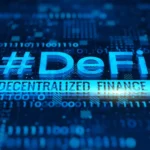Decentralized Finance (DeFi) is revolutionizing the financial landscape by offering open and permissionless access to financial services such as lending, borrowing, trading, and earning interest on digital assets.
Unlike traditional financial systems, DeFi operates without intermediaries, leveraging blockchain technology and smart contracts to facilitate secure, transparent, and efficient financial transactions.
As more people explore alternatives to centralized financial services, DeFi continues to gain traction due to its transparency, inclusivity, and the ability to yield higher returns.
However, getting started can seem daunting for newcomers. This comprehensive guide will walk you through the essential steps to start using DeFi platforms and explore key topics that will help you navigate this exciting and rapidly growing sector.
What is DeFi?
Decentralized Finance (DeFi) refers to a collection of financial applications built on blockchain networks, primarily Ethereum, although other chains like Binance Smart Chain, Solana, and Polygon are gaining popularity.
DeFi removes the need for central authorities by enabling peer-to-peer transactions through smart contracts.
Key Features of DeFi
- Permissionless Access: Anyone with an internet connection can participate without the need for credit checks or lengthy approval processes.
- Transparency: All transactions are publicly verifiable on the blockchain, fostering trust among participants.
- Interoperability: DeFi applications can seamlessly interact with one another, enabling a broad spectrum of financial services.
- Non-custodial: Users retain full control over their digital assets at all times.
- Smart Contracts: Automated and self-executing contracts eliminate the need for intermediaries and reduce operational costs.
- Global Accessibility: DeFi platforms are available to anyone worldwide, eliminating geographical barriers.
Benefits of Using DeFi Platforms

- Financial Inclusion: Provides access to financial services for people without access to traditional banks, particularly in underbanked regions.
- High Interest Rates: DeFi lending, staking, and yield farming often offer significantly higher yields than traditional savings accounts or investment vehicles.
- Transparency and Security: Blockchain technology ensures all transactions are verifiable and immutable, reducing the risks of fraud and corruption.
- Innovation: A variety of novel financial products and services are constantly emerging in the DeFi space, such as flash loans and tokenized assets.
- Flexibility: Users can engage in multiple activities such as yield farming, liquidity mining, staking, and decentralized trading.
- Ownership and Governance: Through governance tokens, users can have a say in the future development of DeFi protocols.
ALSO READ: How to Stay Updated on the Latest Cryptocurrency News?
Step-by-Step Guide to Start Using DeFi Platforms
Step 1: Get a Crypto Wallet
A crypto wallet is essential for interacting with DeFi applications. It allows you to store, send, and receive cryptocurrencies securely.
Recommended Wallets
| Wallet Name | Blockchain Compatibility | Key Features |
|---|---|---|
| MetaMask | Ethereum, BSC, Polygon | Browser extension, mobile app |
| Trust Wallet | Ethereum, BSC, Solana | Mobile-first, user-friendly |
| Ledger | Multi-blockchain | Hardware wallet security |
Setting Up Your Wallet
- Download and Install: Visit the official website of the wallet and download it for your device.
- Create a Wallet: Follow the prompts to create a new wallet.
- Backup Your Seed Phrase: Write down the recovery phrase and store it securely offline. This phrase is crucial for recovering your wallet if lost.
- Connect to Blockchain Networks: Add custom networks like Binance Smart Chain or Polygon if necessary.
Step 2: Fund Your Wallet
To interact with DeFi platforms, you need cryptocurrency.
Steps to Fund Your Wallet
- Purchase Crypto: Buy from reputable exchanges such as Coinbase, Binance, or Kraken.
- Transfer Crypto: Send the purchased crypto to your wallet address. Double-check the destination address to avoid errors.
- Network Selection: Ensure that you send crypto to the correct blockchain network to prevent loss of funds.
Step 3: Choose a DeFi Platform
Select a platform based on your financial goals, such as lending, trading, or yield farming.
Popular DeFi Platforms
| Platform | Use Case | Blockchain |
|---|---|---|
| Uniswap | Trading (DEX) | Ethereum |
| Aave | Lending/Borrowing | Ethereum, Polygon |
| PancakeSwap | Trading (DEX) | Binance Smart Chain |
| Compound | Lending/Borrowing | Ethereum |
| Curve Finance | Stablecoin Trading | Ethereum |
Step 4: Connect Your Wallet to the DeFi Platform
- Visit the DeFi platform’s official website.
- Click on “Connect Wallet.”
- Select your wallet from the list.
- Authorize the connection through your wallet.
Step 5: Explore DeFi Services
Once connected, you can begin using various DeFi services:
Trading on Decentralized Exchanges (DEXs)
- Cryptocurrency Swaps: Instantly trade one cryptocurrency for another.
- Liquidity Provision: Provide liquidity to pools and earn fees.
- Price Discovery: DEXs often offer real-time price discovery for digital assets.
Lending and Borrowing
- Lend Assets: Deposit cryptocurrencies to earn interest.
- Borrow Funds: Use your deposited assets as collateral to borrow other tokens.
- Variable Interest Rates: Rates can fluctuate based on market demand.
Staking and Yield Farming
- Staking: Lock up tokens in a DeFi protocol to earn rewards.
- Yield Farming: Provide liquidity and earn additional tokens as incentives.
- APY Opportunities: DeFi staking often offers attractive annual percentage yields.
Stablecoins for Low Volatility
- Use of Stablecoins: Stablecoins like USDC, DAI, and USDT help mitigate market volatility.
- DeFi Pools: Many DeFi platforms offer specialized pools for stablecoin trading and yield farming.
Step 6: Monitor and Manage Your Investments
- Track Portfolio Performance: Use portfolio trackers like Zerion, Zapper, and Debank.
- Yield Optimization: Regularly review your investments to find better yield opportunities.
- Risk Management: Ensure that your investment portfolio is balanced and aligned with your financial goals.
ALSO READ: How to Conduct Fundamental Analysis on Cryptocurrencies?
Best Practices for Using DeFi Platforms

Security Tips
- Keep Your Seed Phrase Safe: Never share it with anyone.
- Use Hardware Wallets: For added security, store your funds in hardware wallets.
- Enable Two-Factor Authentication: On exchanges and wallet apps to enhance security.
- Stay Informed: Keep up-to-date with the latest security practices and be cautious of phishing sites and scams.
Risk Management
- Understand Smart Contract Risks: DeFi protocols may have bugs or vulnerabilities.
- Diversify Investments: Avoid putting all funds into a single protocol to spread risk.
- Monitor Gas Fees: High fees can reduce your profits, especially on the Ethereum network.
- Liquidity Risks: Be aware of impermanent loss in liquidity pools and assess the risk before providing liquidity.
Additional Topics to Explore
DeFi Governance
Many DeFi protocols have governance tokens, allowing users to vote on platform upgrades and changes.
Popular Governance Tokens
| Token | Platform | Use Case |
|---|---|---|
| UNI | Uniswap | Voting Rights |
| COMP | Compound | Governance |
| AAVE | Aave | Protocol Updates |
| MKR | MakerDAO | Decision Making |
Layer 2 Solutions
Layer 2 solutions aim to reduce transaction costs and improve scalability.
Popular Layer 2 Networks
| Network | Blockchain | Features |
|---|---|---|
| Polygon | Ethereum | Low gas fees |
| Arbitrum | Ethereum | High throughput |
| Optimism | Ethereum | Scalability |
| zkSync | Ethereum | Privacy Focus |
Cross-Chain Compatibility
Many DeFi platforms are becoming cross-chain compatible, allowing users to move assets across different blockchains seamlessly. Projects such as Cosmos, Polkadot, and Thorchain are at the forefront of this innovation.
The Future of DeFi

- Integration with Traditional Finance: Bridging DeFi and traditional finance to offer hybrid financial services.
- Improved Security Measures: Enhancing smart contract security and developing insurance protocols to protect users.
- Regulatory Developments: Governments and regulatory bodies are exploring ways to regulate DeFi while maintaining its decentralized nature.
- New Financial Products: DeFi is likely to offer new products like synthetic assets, prediction markets, and decentralized identity solutions.
ALSO READ: How to Create a Crypto Wallet: A Step-by-Step Guide?
Conclusion
Getting started with DeFi platforms can be both exciting and rewarding. By following this step-by-step guide, you can confidently navigate the world of decentralized finance, make informed decisions, and take advantage of the innovative financial services DeFi offers.
Remember to stay vigilant, continuously educate yourself, and practice sound investment strategies to make the most out of your DeFi journey.







